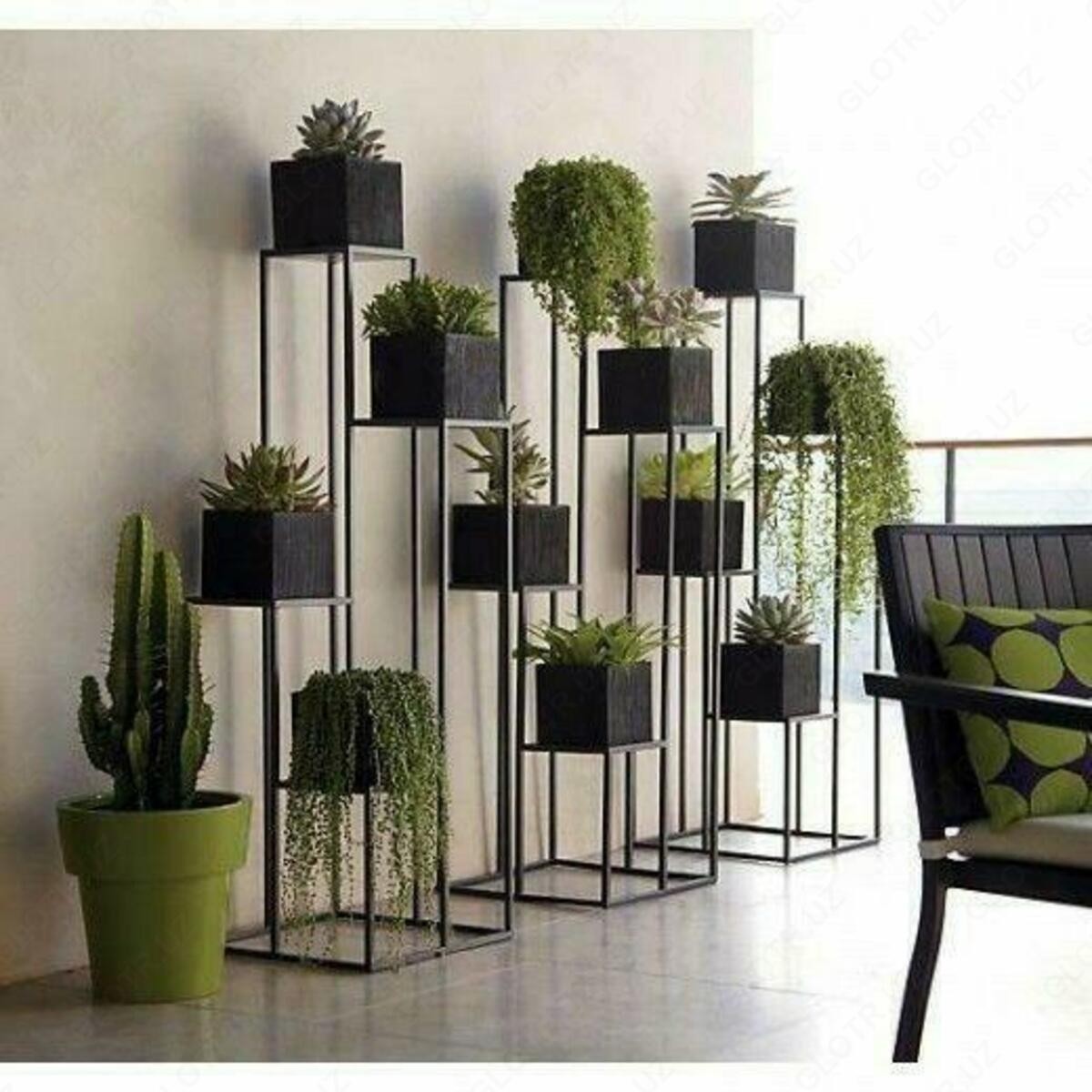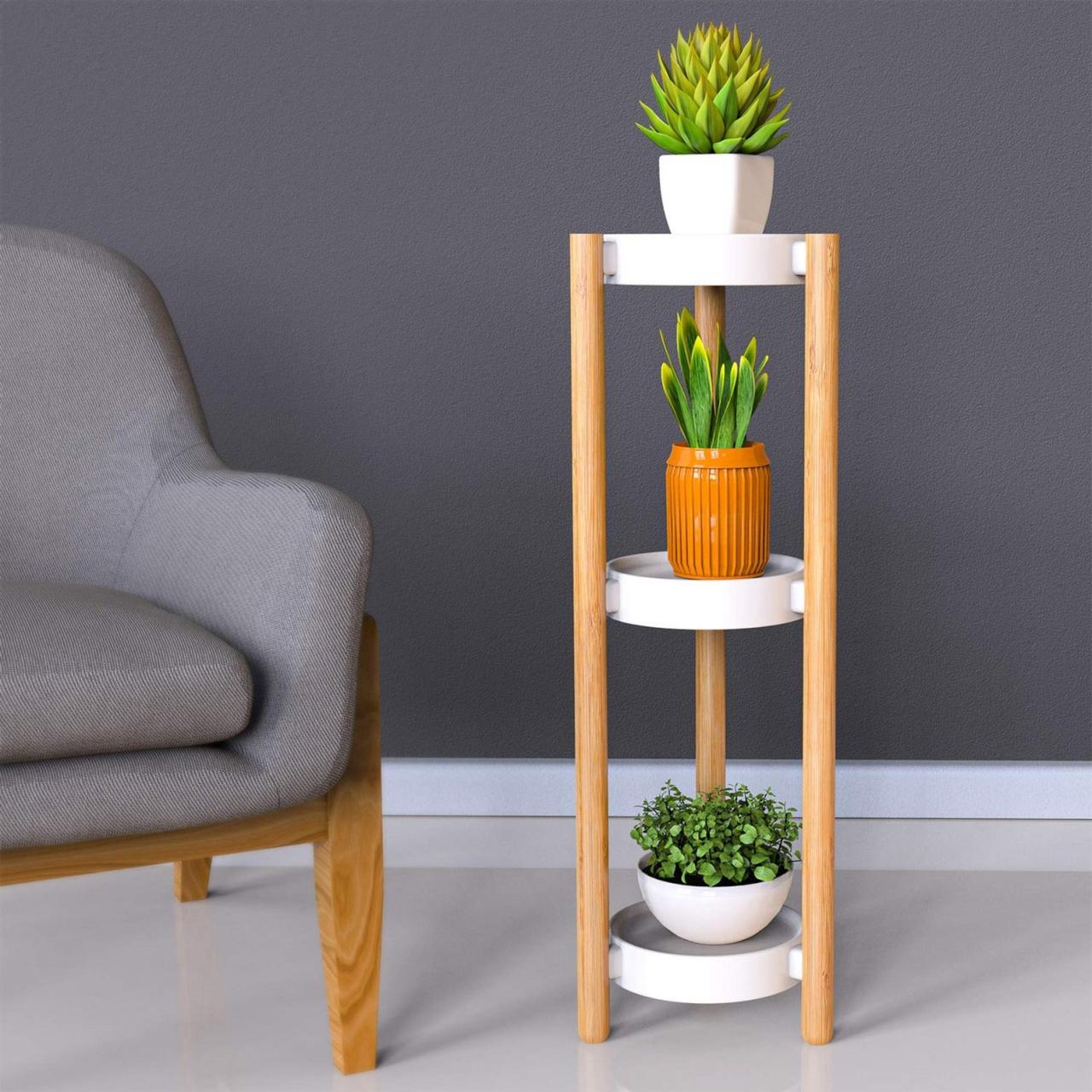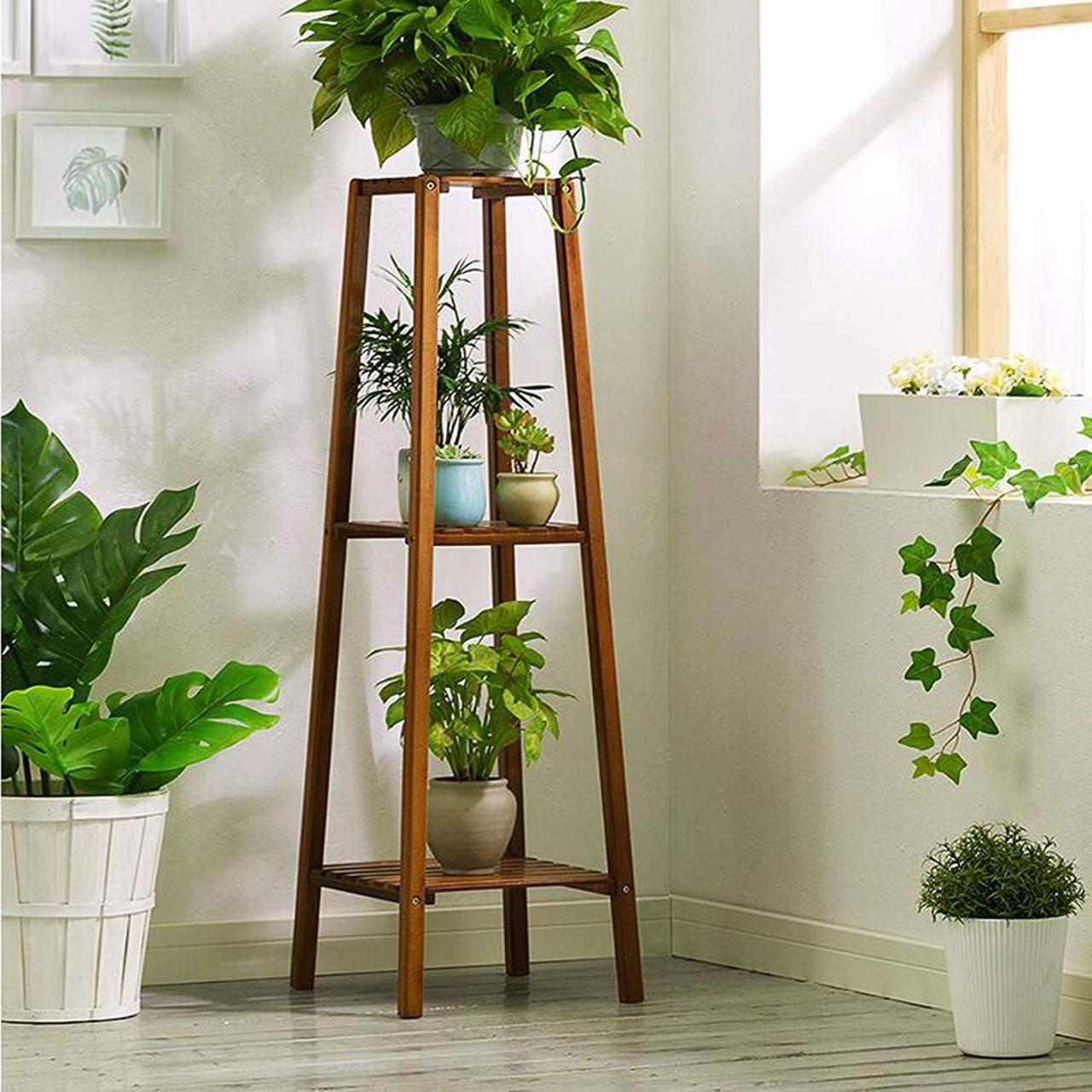Best Plant Stands for Large Indoor Plants: Imagine a lush, verdant jungle right in your living room. Large indoor plants bring a touch of nature indoors, but finding the right stand to showcase their beauty and ensure their stability can be a challenge.
Plant stands are more than just decorative pieces; they play a crucial role in maximizing space, enhancing aesthetics, and providing the necessary support for your leafy companions to thrive.
This guide delves into the world of plant stands, exploring the different types available, key factors to consider when making your selection, and even provides DIY ideas for those who love a touch of personalization. We’ll also recommend suitable stands for specific large indoor plants, ensuring that you find the perfect match for your green giants.
Introduction: Best Plant Stands For Large Indoor Plants
Large indoor plants bring a touch of nature indoors, but they often require substantial space and stability. Plant stands are essential for showcasing these leafy giants, providing a dedicated platform for them to thrive. They elevate the plants, enhancing their visual appeal and maximizing the use of floor space.
Benefits of Plant Stands for Large Indoor Plants
Plant stands offer numerous benefits, making them an indispensable part of indoor gardening. They not only enhance the aesthetic appeal of your plants but also contribute to their well-being.
- Enhanced Aesthetics: Plant stands act as pedestals, drawing attention to your plants and transforming them into captivating focal points in your home. They allow you to display large plants at eye level, showcasing their beauty and adding a touch of elegance to your interior design.
- Space Maximization: By elevating your plants, plant stands free up valuable floor space. You can strategically place them in corners or against walls, making the most of your room’s layout. This is especially beneficial for smaller homes or apartments where space is limited.
- Stability and Support: Large plants can be top-heavy, making them susceptible to tipping over. Plant stands provide a stable base, ensuring the safety of your plants and preventing potential damage.
Types of Plant Stands

Choosing the right plant stand for your large indoor plants is crucial for their health and your home’s aesthetics. The type of stand you select will depend on your plant’s size, the space available, and your personal style.
Plant Stand Types
Different types of plant stands are available, each with its own unique characteristics and advantages. Here is a table summarizing the main types of plant stands and their suitability for large indoor plants:
Type |
Description |
Advantages |
Disadvantages |
|---|---|---|---|
Classic Plant Stand |
Typically a single-tiered structure with a round or square base and a flat top. They come in various materials, including wood, metal, and plastic. |
Versatile, affordable, and easy to find. |
Limited space for large plants, may not be sturdy enough for heavy plants. |
Tiered Plant Stand |
Features multiple tiers or shelves to accommodate multiple plants at different heights. |
Maximizes space, allows for displaying a variety of plants. |
Can be bulky and require more space, may be difficult to move. |
Rolling Plant Stand |
Equipped with wheels for easy movement and repositioning. |
Convenient for moving plants around, can be used in different areas of the home. |
May be less stable than other stands, can be noisy on hard floors. |
Hanging Plant Stand |
Consists of a hanging structure, such as a macrame hanger or a metal frame, that suspends plants from the ceiling or a wall. |
Saves floor space, adds a unique and decorative element to the room. |
May not be suitable for very heavy plants, requires ceiling or wall mounting. |
Wall-Mounted Plant Stand |
Designed to be attached to a wall, offering a space-saving solution. |
Ideal for small spaces, adds a modern touch to the room. |
Limited space for large plants, may require drilling into walls. |
Factors to Consider When Choosing a Plant Stand

Choosing the right plant stand is crucial for showcasing your indoor greenery and ensuring their well-being. There are several factors to consider before making a purchase.
Plant Size and Weight
The size and weight of your plants play a significant role in selecting the appropriate plant stand. Large, heavy plants require sturdy stands that can support their weight without tipping over.
- For small plants, a lightweight stand with a small footprint is sufficient.
- For medium-sized plants, consider a stand with a wider base and a sturdy construction.
- For large, heavy plants, a stand made from heavy-duty materials like metal or wood is essential.
Room Size and Layout
The size and layout of your room will determine the type and size of plant stand that fits best.
Choosing the right plant stand for your large indoor plants is crucial, not just for aesthetics but also for their well-being. A sturdy stand provides stability, especially for heavier plants like the Money Plant, which can get quite large.
To keep your Money Plant looking its best, it’s essential to provide it with the right conditions, including proper light, water, and humidity, as outlined in this guide: How To Keep Your Money Plant Looking Green And Lush. Once you’ve mastered the care routine, you can choose a plant stand that complements your décor and enhances the beauty of your thriving Money Plant.
- In smaller rooms, a compact stand that doesn’t take up too much floor space is ideal.
- For larger rooms, you have more flexibility to choose a larger stand or even multiple stands to create a cohesive display.
- Consider the placement of the stand in relation to other furniture and traffic flow in the room.
Style and Aesthetics
The style of the plant stand should complement the overall aesthetic of your home.
- Modern homes often feature minimalist stands with clean lines and geometric shapes.
- Traditional homes may prefer more ornate stands with intricate carvings or decorative elements.
- Consider the color and finish of the stand to ensure it blends well with your existing décor.
Material and Durability
The material of the plant stand affects its durability, longevity, and overall aesthetic.
- Wood is a classic and durable material that can be stained or painted to match your décor.
- Metal stands are often lightweight and can be found in various styles and finishes.
- Plastic stands are affordable and easy to clean, but may not be as durable as wood or metal.
Budget
Plant stands are available in a wide range of prices, from budget-friendly options to high-end designer pieces.
- Consider your budget and prioritize the features that are most important to you.
- You can find quality stands at various price points by shopping around and comparing options.
Best Plant Stands for Specific Large Indoor Plants
Choosing the right plant stand for your large indoor plants is essential for their health and aesthetic appeal. The right stand will provide stability, support, and showcase your plant’s beauty while complementing your decor. This section explores the best plant stands for specific large indoor plants, considering their size, shape, and growth habits.
Plant Stands for Specific Large Indoor Plants
Here is a table that lists popular large indoor plants and recommends suitable plant stands for each. The table also provides an explanation for the recommended stands based on the plant’s size, shape, and growth habits.
Plant |
Recommended Stand Type |
Explanation |
|---|---|---|
Fiddle Leaf Fig (Ficus lyrata) |
Tall, sturdy tripod stand |
Fiddle leaf figs can grow quite tall, and a tripod stand provides a stable base to support their weight. The three legs also offer good stability, preventing the stand from tipping over. |
Monstera Deliciosa |
Wide, tiered stand |
Monsteras are known for their large, sprawling leaves. A tiered stand allows the plant to grow upwards and outwards, providing ample space for its leaves to spread. The tiers also offer a display area for other plants or decor. |
Bird of Paradise (Strelitzia reginae) |
Heavy-duty, wheeled stand |
Bird of paradise plants can grow quite large and may need to be moved occasionally. A wheeled stand provides easy mobility, allowing you to adjust the plant’s position as needed. The heavy-duty construction ensures stability even when the plant is fully grown. |
Rubber Tree (Ficus elastica) |
Simple, freestanding stand |
Rubber trees have a more upright growth habit and can be quite tall. A simple, freestanding stand provides a stable base and allows the plant to stand out on its own. |
Snake Plant (Sansevieria trifasciata) |
Low, decorative stand |
Snake plants have a more compact growth habit and don’t require a lot of vertical space. A low, decorative stand can add a touch of elegance to the plant and complement your decor. |
DIY Plant Stand Ideas
Creating your own plant stand is a rewarding project that allows you to personalize your space and cater to the specific needs of your large indoor plants. You can craft unique and stylish stands from readily available materials, adding a touch of character to your home while providing the perfect support for your leafy companions.
Plant Stand Ideas Using Recycled Materials
Repurposing old items into plant stands is an eco-friendly and budget-friendly option. These DIY projects offer a chance to breathe new life into discarded objects, adding a unique touch to your home décor.
- Old Ladders:A vintage ladder can be transformed into a charming plant stand. You can simply lean it against a wall or secure it to the floor for stability. Place pots of varying sizes on each rung, creating a cascading effect.
Consider painting the ladder in a bright color to enhance its visual appeal.
- Wooden Crates:Wooden crates are readily available and can be easily stacked or arranged to create a multi-tiered plant stand. Sand and paint the crates in your desired color, or leave them in their natural wood finish for a rustic look.
- Wine Barrels:Wine barrels, once their contents are enjoyed, can be repurposed as sturdy plant stands. The barrel’s natural shape and texture add a rustic charm to your space. You can leave the barrel as is or cut a hole in the top to create a planter.
Building a Plant Stand from Scratch
For a custom-designed plant stand, consider building one from scratch. This allows you to tailor the dimensions and style to your specific needs and preferences.
- Simple Wooden Stand:A basic wooden stand can be constructed using plywood or lumber. Cut and assemble the pieces to create a rectangular or square frame. You can add shelves or a single platform to accommodate your plants. Finish the stand with paint, stain, or varnish to enhance its appearance.
- Industrial Pipe Stand:For a modern and industrial look, consider using galvanized pipes and fittings to build a plant stand. Connect the pipes to create a sturdy frame and attach a wooden platform or shelves. This style complements minimalist décor and adds a touch of urban chic.
Choosing the right plant stand for your large indoor plants can enhance their beauty and create a balanced aesthetic. If you’re looking to grow a stunning money plant, remember that proper care is crucial for promoting fuller growth. You can find detailed advice on nurturing your money plant’s lush foliage in this comprehensive guide, Money Plant Care: How To Promote Fuller Growth.
Once you’ve mastered the art of money plant care, you can showcase its vibrant growth on a stylish and sturdy plant stand, allowing it to truly take center stage in your home.
- Rustic Pallet Stand:Repurposed pallets can be used to create a rustic and eco-friendly plant stand. Disassemble the pallet and use the planks to build a multi-tiered stand. Sand and stain the wood for a polished look, or leave it in its natural state for a more rustic feel.
Maintaining Plant Stands
Just like your plants, your plant stands need care to ensure they remain sturdy and functional. Regular maintenance will help extend their lifespan and keep your indoor greenery looking its best.
Cleaning Plant Stands
Regular cleaning is essential for maintaining the appearance and hygiene of your plant stands. Dust, dirt, and grime can accumulate over time, affecting their aesthetic appeal and potentially harming your plants.
- Wipe down surfaces regularly:Use a damp cloth to wipe down the surfaces of your plant stands, removing any dust or debris. For wooden stands, you can use a specialized wood cleaner or a mild soap solution.
- Clean between shelves:If your stand has multiple shelves, ensure you clean the spaces between them to remove any accumulated dirt or debris.
- Wash metal stands:Metal plant stands can be cleaned with a mild soap solution and a soft cloth. Avoid abrasive cleaners, as they can damage the finish.
Repairing Plant Stands
Over time, plant stands can experience wear and tear, requiring repairs to ensure their stability and safety.
- Tighten loose screws:Regularly check for loose screws and tighten them to prevent the stand from becoming unstable.
- Replace damaged parts:If any parts of the stand are damaged, replace them promptly. This might involve replacing broken shelves, wobbly legs, or damaged brackets.
- Reinforce weak spots:If you notice any weak spots or cracks in the stand, consider reinforcing them with wood glue or epoxy resin.
Safety Precautions, Best Plant Stands for Large Indoor Plants
Safety should always be a priority when using plant stands.
- Inspect regularly:Before placing your plants on a stand, always inspect it for any signs of damage or instability.
- Avoid overloading:Ensure that the stand is strong enough to support the weight of your plants. Overloading can lead to instability and potential accidents.
- Use a safety mat:If your plant stand has a smooth surface, consider using a safety mat underneath to prevent it from slipping.
Last Word

Choosing the right plant stand for your large indoor plants is an investment in their well-being and the overall aesthetic of your space. By considering the factors discussed in this guide, you can find a stand that not only supports your plants but also complements your décor and enhances your living environment.
Remember, a well-chosen plant stand is more than just a piece of furniture; it’s a statement piece that reflects your love for nature and your commitment to creating a vibrant, green oasis within your home.
Essential Questionnaire
What are the best materials for plant stands?
The best material depends on your needs and preferences. Metal stands are durable and modern, while wood stands offer a classic and rustic look. Plastic stands are lightweight and affordable, but they might not be as sturdy.
How do I choose the right size plant stand for my plant?
The stand should be proportionate to the size of the plant. The base should be wide enough to provide stability, and the height should allow the plant to receive adequate sunlight.
Can I use a plant stand for multiple plants?
Yes, you can use a plant stand for multiple plants, but make sure the stand is sturdy enough to support the combined weight. Consider using a tiered stand or a shelf to create a cascading effect.
How do I maintain my plant stand?
Regular cleaning with a damp cloth is usually sufficient. For wooden stands, you may need to apply a sealant or oil to protect them from moisture and damage.
